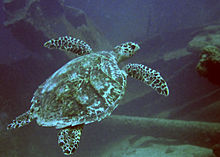Antilla (ship)
|
||||||||||||||||||
|
||||||||||||||||||
|
||||||||||||||||||
The Antilla was a 1939-built cargo ship of Hapag , which should be used for the America trade. Already in 1940 it was self- scuttled during the Second World War on its maiden voyage off Aruba ; the wreck is now a popular destination for divers .
history
The Antilla was built in 1939 as a West India freighter for Hapag in the Deutsche Werft AG in Hamburg-Finkenwerder ; Sister ships were the type ship Orizaba, also built by the Deutsche Werft, and the Arauca , which was delivered as the third ship , which was built by the Bremer Vulkan . On July 11, 1939, the Antilla was finally completed, four days later she set off loaded with German goods under Captain Ferdinand Schmidt on her maiden voyage to the Caribbean. At the beginning of August it reached the Dutch colony of Curaçao , followed by ports in Colombia ( Puerto Colombia and Cartagena ), Panama , Costa Rica and Guatemala .
At the end of August she was in Galveston (Texas) and was laden with sulfur when, due to mobilization for the attack on Poland , all German merchant ships overseas were given a secret order to seek protection in the territorial waters of neutral states. The Antilla first went to Cartagena to fill up with fuel, and then tried to moor in the port of Curaçao, but since this was already overcrowded, the ship (together with the Consul Horn , Troja and Heidelberg ) had to move to Aruba, where one had to go San Nicolas anchored. Since the Second World War had broken out on September 1, the ships were now stuck in Aruba - surrounded by Allied warships. The Dutch administration of the island allowed them to stay within the territorial waters and on September 15 assigned them a quieter anchorage in the northwest near Malmok , where the four ships remained for the next few months. After two months, the Antilla returned briefly to San Nicolas to unload the sulfur load there.
At the beginning of January 1940, Consul Horn , disguised as a Soviet freighter, managed to break out and successfully return to Europe. The Troy and the Heidelberg tried to break out, but were caught on March 1st and 2nd and sank themselves. The Antilla also dared a short attempt to escape, but broke it off immediately when an Allied warship was discovered and remained there as the only German ship off Aruba.
As of April 12, the crew was no longer allowed to leave their ship in view of the impending German invasion. After the Wehrmacht actually attacked the Netherlands on May 10, the ship was now in hostile waters. The Dutch government declared a state of war and ordered the confiscation of all German merchant ships, whereupon the Antilla was stormed by marines at 5 a.m. local time on the same day and the remaining 35 crew members were arrested. A first attempt to occupy the ship shortly after midnight, however, failed, so that the German crew still had enough time to damage the ship so severely by opening the sea valves and setting fire to the ship that it could no longer be saved by the Dutch and was shallow Water sank. Due to the severe destruction of the central part of the ship that is visible today, a boiler explosion is often assumed to be the cause of the sinking. This is contradicted by the fact that none of those involved mentioned an explosion and that the hull was still intact immediately after the sinking and was probably only destroyed by the sea in the early 1950s .
Some time later the rumor arose that the Antilla was in fact a camouflaged submarine supply ship , which is very unlikely since there are no documents for this and the ship was unsuccessful on military even after its arrival in Aruba Cargo was examined.

wreck
The wreck - often colloquially called the Ghost Ship today - is located on its port side about 700 m from the coast (position: 12 ° 36 ′ 7 ″ N , 70 ° 3 ′ 28 ″ W ) away at eighteen feet. It's broken in two; the center of the ship was completely destroyed, but the bow and stern are still well preserved. For a long time, the remaining structures protruded from the water at low tide, but in January 2009 they were torn off by the current. Over time, numerous creatures have settled in and on the wreck, making the site one of the most popular wreck diving spots in the Caribbean.
literature
- Ludwig Dinklage: The German merchant fleet 1939–1945 , Frankfurt, 1971.
- Christina P. Colón: Frommer's Portable Aruba, Bonaire, Curaçao , 6th Edition, John Wiley & Sons , p. 87.
Web links
- Prelude for the scuttling of the Antilla, the lost wreck of the Troja and True story of es. Antilla (1939) and her crew on the private site willemsubmerged.wordpress.com
- FAZ.net : Aruba: dive to the shipwreck
